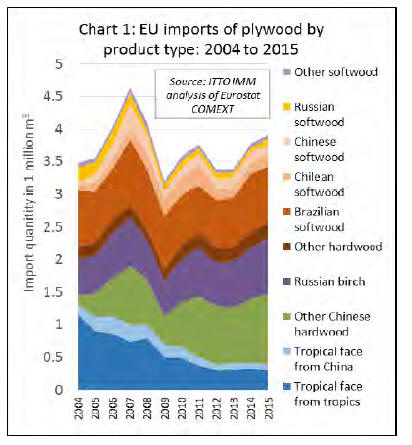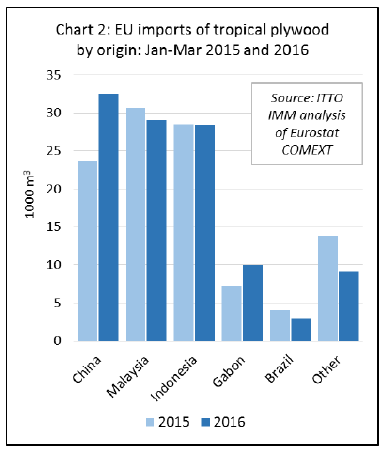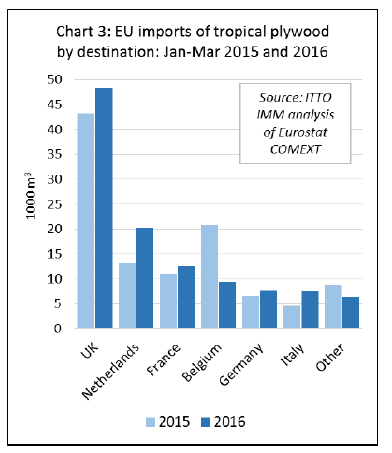|
Report from
Europe
EU reviews impact of VPAs and EUTR
On 4 May, the European Commission (EC) published a
comprehensive independent evaluation of the EU FLEGT
Action Plan. The Plan encompasses the wide range of EU
policy measures introduced over the last decade to support
good forest governance and remove illegal wood from
trade.
Key amongst these are the EU Timber Regulation (EUTR)
and the Voluntary Partnership Agreements (VPAs) now
being implemented by six tropical countries and
negotiated by another nine countries. The report assesses
progress since the Plan¡¯s publication in 2003 and makes
recommendations for future action.
The report¡¯s central conclusions are positive: the EU
FLEGT Action Plan is assessed to be a relevant and
innovative response to the challenge of illegal logging and
to have improved forest governance in all target countries.
The report says the EU FLEGT Action Plan has been
effective in terms of raising awareness of the problem of
illegal logging at all levels, contributing to improved forest
governance globally and particularly in partner producer
countries, and has helped reduce demand for illegal timber
in the EU.
The report¡¯s recommendations imply that the Plan is
heading in the right direction and not needing a major
overhaul. ¡°Main pillars and action areas should be
retained, but FLEGT support to producing countries
should be delivered in a more demand-driven and flexible
manner, while bottlenecks affecting VPAs should be
addressed and the private sector more involved¡±.
The report suggests that ¡°the direct FLEGT objective of
decreased EU imports of illegal wood is being achieved¡±.
This observation is based largely on the results of
interviews and perception surveys undertaken by the
consultants both in the EU and producer countries over the
last two years rather than any direct evidence from
changes in trade flows.
Assessments of trade flows have yet to reveal any
significant step change in trade that can readily attributed
to measures such as the EUTR and VPAs which are
central to the FLEGT Action Plan.
Lack of progress on trade aspects of FLEGT
The report highlights that while the Action Plan is
contributing broadly to its specific objectives, it¡¯s
effectiveness across action areas varies widely. It notes
that progress on trade aspects of the plan has been a
particular area of weakness and that there is a need for
greater focus on VPA and EUTR implementation and
private sector engagement.
The report suggests that the VPA process has yet to
deliver on the Action Plan objective of increasing market
confidence for timber from participating countries. In fact,
interviews in VPA countries as part of the evaluation
indicated that many observers feel that the EU market is
now less confident than before about tropical timber.
To a large extent this failure to increase market confidence
is tied up with the lengthy time between signing a VPA
and delivery of FLEGT licensed timber. The report is
blunt in its assessment of efforts to develop Timber
Legality Assurance Systems (TLAS) noting that
¡°generally speaking, the TLAS projects have met with
little success¡±.
According to the report, out of 200 responses to the Public
Survey, less than 5% consider the TLAS to be a major
achievement of the FLEGT Action Plan.
Furthermore, responses to the VPA-country survey
undertaken by the consultants indicate that countries
implementing a VPA still consider the TLAS to be a
challenge.
The reasons vary from country to country: in Cameroon,
Congo and CAR the Wood Tracking Systems (WTS)
development and acquisition projects have so far been
difficult to manage and expensive; in Vietnam, there have
been disagreements between the partners on approaches to
TLAS development, including the scope of verification; in
Malaysia the need for capacity building to run the TLAS
has been underestimated.
Moreover, VPA countries find it hard to accept the lack of
recognition of their efforts to enhance their broader
governance framework (in the absence of FLEGT licenses
they are treated like any non-VPA country). This has led
several countries (Vietnam, and Congo) to propose a
phased application of the TLAS, while in Cameroon such
is being suggested by stakeholders.
FLEGT licensing in Ghana and Indonesia close to
operational
More positively, the report suggests there is general
recognition that VPA negotiation and implementation,
strongly supported by EFI, the EC and EU Member States,
have helped to sharpen the legality definition, and this has
been valuable, even if no functioning TLAS has been
produced.
The VPA Survey revealed that three VPA implementing
countries acknowledge the positive effect of the legality
definition process on the development of the TLAS. And
despite the challenges, two countries ¨C Ghana and
Indonesia ¨C now have systems very close to operational.
Another observation is that the Action Plan¡¯s contribution
to the objective of sustainable forest management is
unclear and needs to be made more explicit. According to
the report, available data suggest that the TLAS under
development are not necessarily enhancing more
sustainable forest management (SFM) or SFM
certification, and that this is not envisaged by many
stakeholders in VPA countries.
There¡¯s also a concern that FLEGT needs to focus more
on domestic timber markets and support for the actors
operating in them. This is seen as critical to the broader
FLEGT objective of contributing to poverty reduction.
Slow EUTR implementation weakens incentives.
Considering the EU demand side, the report echoes many
of the conclusions of the EU review of the EU Timber
Regulation published earlier this year. The report suggests
there is a widespread perception that EUTR has been
implemented slowly and unevenly and that this is
decreasing incentives for VPA countries to commit to
finalising FLEGT licensing systems.
The report notes that ¡°while advances have been made [on
EUTR implementation], there have been major differences
between front-runner [EU] countries and slow followers.
This has resulted in unfair competition between Member
States, inconsistent market requirements for the private
sector in producer countries and a risk that VPAs would
lose their value and the EC some of its credibility¡±.
The report goes on to suggest that the capacity of most
EUTR authorities is considered rather limited, in terms of
staff numbers, budgets and training. In important timberimporting
countries, such as the Netherlands and Belgium,
only three and half a full-time equivalent staff,
respectively, has been assigned to EUTR enforcement.
It¡¯s noted that while big EU companies started developing
due diligence (DD) systems at an early stage - which had
sometimes resulted in a significant reduction in their
number of suppliers - and were ready to exercise DD when
the EUTR came into force, the vast majority of companies
across the EU applied a ¡°wait and see¡± mentality.
Unless there is effective implementation, control and
prosecution on the one hand, and sufficient and clear
guidance on the other, especially the SMEs seem unlikely
to change their practice.
EUTR beginning to change trade practices
Nevertheless, the report suggests that EUTR is beginning
to change trade practices in those countries where
implementation is more advanced.
Specific changes identified include: increased awareness
on risk of illegal timber; increased import of certified
timber and a push to certification in some producer
countries; positive influence on legislation in producer
countries; and some benefits emerging for legal producers
due to exclusion of low priced illegal timber from the
market.
To some extent these benefits are offset by negative
changes including an increased cost and administrative
burden on operators, the withdrawal of SMEs in producer
countries from export markets, and confusion and
concerns in producer countries due to the lack of
harmonised implementation across EU countries.
The findings and recommendations of the report will now
guide the EC in improving the efficiency, effectiveness
and value-for-money of work undertaken to further
implement the Action Plan. The report will also guide the
EC in assessing policies to address the broader drivers of
deforestation, and in linking action under FLEGT to the
international climate change and Sustainable Development
Goals agendas.
Further details including a complete copy of the reported is
available at: http://www.euflegt.efi.int/eu-flegt-evaluation
Tropical plywood share falls to all time low in EU
Latest EU import data shows that tropical plywood has
continued to lose share in the EU plywood market over the
last two years.
While EU imports of plywood from all sources increased
sharply between 2013 and 2015, from 3.38 million cu.m to
3.92 million cu.m, a level not seen since before the
financial crises, imports from the tropics have remained
stubbornly low (Chart 1).
After increasing 4% to 324,000 cu.m in 2014, EU imports
of plywood from tropical countries fell back 6% to
305,000 cu.m in 2015. The share of tropical countries in
EU plywood imports fell from 9.2% in 2013 to only 7.8%
in 2015, the lowest level for at least the last 20 years, and
probably much longer.

The share of imports of tropical hardwood faced plywood
from China also fell in the last two years, from 3.0% in
2013 to 2.4% in 2015.
Tropical hardwood faced plywood has lost share mainly to
Chinese plywood faced with temperate hardwood
(including poplar, eucalyptus and birch), and to Russian
birch plywood.
EU imports of temperate hardwood plywood from China
increased from 986,000 cu.m in 2014 to 1.07 million cu.m
in 2015 and share of imports increased from 26.1% to
27.2%. Over the same period, EU imports of Russian birch
plywood increased from 782,000 cu.m to 863,000 cu.m
and share increased from 20.7% to 22.0%.
Further gains by Russia and China in the EU market in the
last two years are likely due to the combined effects of the
weak Russian rouble, declining value of the Chinese yuan
and falling domestic demand in China, and rising
availability of plantation wood from China.
Weakness of the euro against the dollar during 2015 will
also have reduced sales of South East Asian plywood in
the EU.
Early indications are that the share of tropical countries in
EU plywood supply has continued to erode during 2016.
EU imports of plywood faced with tropical hardwood
were up 3.7% in the first three months of 2016 compared
to the same period last year.
However, this was largely due to a 38% rise in EU imports
of tropical hardwood plywood from China, from 23,700
cu.m in the first quarter of 2015 to 32,600 cu.m during the
same period in 2016.
So far this year, China has been the EU¡¯s largest supplier
of tropical hardwood plywood (Chart 2).

Imports from Malaysia were down 5.4% at 29,000 cu.m in
the first quarter of 2016 and imports from Indonesia
remained static at 28,400 cu.m.
Of significant suppliers in the tropics, only Gabon
registered an increase in exports to the EU in the first three
months of 2016, with a gain of 37% to 10,000 cu.m
compared to the same period in 2015. The latter is a trend
worth watching as perhaps signalling the first sign of
growth in the EU market for African okoume plywood
after many years of recession.
The gain in EU imports of plywood from Gabon in 2016
has been concentrated in Italy and the Netherlands, with a
much smaller gain in France where trade in this product is
still very limited.
The increase in EU imports of tropical hardwood faced
plywood from China this year has been concentrated
mainly in the UK and Netherlands (Chart 3). This is
notable from the perspective of EUTR and forest
certification, since importers and EUTR authorities in both
countries are renowned for their relatively rigorous efforts
to ensure wood is risk-free from an illegal logging
perspective.
This implies that a significant proportion of this material is
faced with certified tropical hardwood, or at least that
Chinese manufacturers are now successfully reassuring
customers of the legality of their tropical veneer supplies
by other means.
Another notable trend in the first quarter of 2016 was the
low level of import of tropical hardwood plywood into
Belgium, at 9,400 cu.m, less than half the same period in
2015. Belgian imports of plywood from Indonesia have
been much slower in 2016 than in 2015, although the fall
in Belgium has been offset by rising Indonesian exports to
the UK, Netherlands, Italy and Germany in 2016.

|